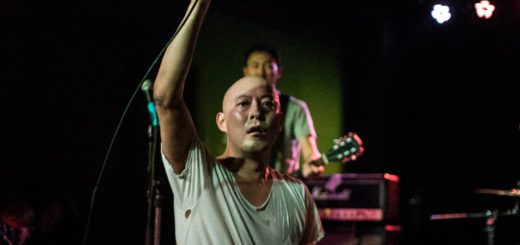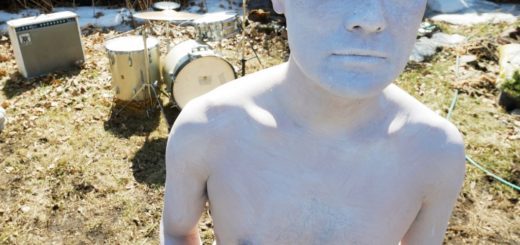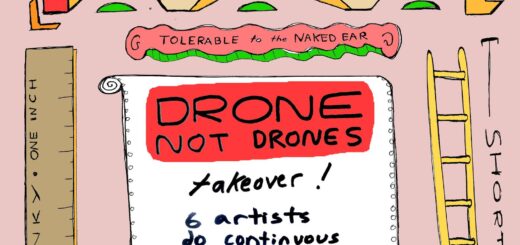Interview: Celica’s Sho Nikaido
A new music video marks the end of a
creative cycle and the dawn of new
direction for photographer and guitarist
Noboru ‘Sho’ Nikaido
Sound & Vision
The word ‘nostalgia’ comes from the Greek root nostos, which means returning home, and algos, meaning pain or aching. Seated in front of a steaming bowl of noodles in a south Minneapolis restaurant, Sho Nikaido is thinking about memory, creativity, and the feeling of missing home.
“Furusato is a word we use in Japanese. It means home as something that you long for, being far away from it. For me, that’s exactly the thing. On one hand, I long for my ocean town, the place where I grew up, but also, it’s good to be away from home sometimes. Let’s say you grow up in your home, and always stay in your home, then I think maybe you can’t really understand your home.”

Sho Nikaido at Pho 79 on Nicollet Avenue, Minneapolis, May, 2025. Photo: Croix Clayton
Nikaido’s hometown of Kamakura city sits at the southernmost reach of Tokyo’s megacity sprawl, where the Japanese coastline slips into the blue waters of Sagami Bay, and the horizon hovers over thousands of miles of ocean, rolling southward toward distant New Guinea. Just a ten-minute bike ride from Kotoku-in Temple, where one of the world’s most iconic buddha statues, the Kamakura daibutsu-sama (big buddha) sits in eternal cross-legged focus, Inamura point beach occupies a tiny spit of land jutting out into the ocean. Surfers slalom elegantly past the rocky jewel of Enoshima Island, and on clear days, Mount Fuji itself towers blue and silent in the distant west.
One sunny afternoon in the late 1980s, a seventeen-year-old Nikaido walked out of high school with his girlfriend, secretly escaping to Inamura Point. Savoring the taste of rebellion, they hurried down the road, descending the forested path to the bright sand of the beach, where they stood in their uniforms, smoking and looking out at Sagami Bay. Enoshima Island floated above the sparkling waters like a cloud made solid.
“Looking back, that was actually my first real experience of life,” Nikaido explains. “People come from all over Japan for this view, but I’m from Kamakura, so it didn’t seem that special to me. I didn’t really give a shit,” he laughs. But their revelry ended when an angry teacher found them out. The entire volleyball team (on which he played) was punished for Nikaido’s delinquency, and his girlfriend dumped him over the social fallout. Now stigmatized as a ‘bad kid,’ he was persona non grata at school. “If I hadn’t played hooky that day, I probably never would have moved to America,” he reflects. Having been accepted to the University of Minnesota, Nikaido was listening to Nirvana on his Sony DiscMan as his plane touched down at MSP airport.
While pursuing a degree in photography at the U of M, he would sing for raucous garage punk outfit Sweet JAP (short for ‘Sweet Japanese American Princesses’) which he co-founded in 1999 with fellow expats, including Hideo Takahashi (Birthday Suits, Green/Blue), and drummer and chef/restauranteur-to-be Matthew Kazama (Birthday Suits), who joined Sweet JAP towards the end of the band’s tenure, and with whom Nikaido would later collaborate in noisy 2010s post-krautrock improv unit, Seated Heat.
Sweet JAP, “I’m Only Moonlight”: photo by Sho Nikaido
After Sweet JAP called it quits in 2004, Nikaido picked up a guitar and started a two-piece group, Mute Era, with his then-wife, drummer Jess Driscoll. Exploring the blasted art rock and post-punk peripheries of a world where ‘indie’ had degenerated into a new code-word for anodyne pop played on rock instruments, Mute Era released a handful of compelling EPs on small-run CDR format, though the duo largely built their reputation on ferocious live sets.
Mute Era, live at the Turf Club in St. Paul, April 6, 2007. Courtesy of Midwestern Social Research
But despite this forward musical momentum, the end of the new millennium’s first decade found Nikaido exhausted and directionless. Though he had been accepted to the prestigious School of Visual Arts in New York City to study photography back in 2002, he had quit shortly after matriculating, ultimately abandoning photography itself in the process. “Photography disappointed me…it’s a love-hate relationship, I guess. I just stayed away from it.” For several years he would focus exclusively on music. In 2009, a distraught Nikaido returned to Kamakura to visit family. A dysfunctional marriage – which would soon end in divorce – weighed on his thoughts. Home again, he walked down to his old haunt at Inamura point beach, to watch the surfers and see the tide roll in. As the sun sank low on the horizon, Nikaido was suddenly overwhelmed by a glorious wash of pink and gold that seemed to express everything he had been feeling; the melancholy beauty of endings and the vain desire to return to times and experiences long gone. But in the moment, he snapped a single photograph of the glowing sky where the sun had dipped into the green surf of Sagami Bay, and quietly walked back to his parents’ home.
Celica, “Bouquet for the Sunset U’ve Never Seen”: photo by Sho Nikaido
New Directions
Years would pass before Nikaido developed that photo. This was a decade during which he averaged about a roll of film per year. But when he did finally develop and print the shot from Inamura point, he was stunned. It looked magical. Everything he had thought about that day back in 2009 came back to him. “I had kind of got lost for a long time…for close to ten years I didn’t really take photographs. But looking at the negatives from that day, that picture was so beautiful; I felt like it was saying something to me. I just wanted to share it. I thought ‘seriously, why am I here?’ Because I belong to Japan, but I feel I belong to Minnesota too. I realized I wanted to show this sunset – show my home – to my friends in Minnesota. I also realized I needed to show Minnesota to my family and friends back in Japan.” It was slow, but Nikaido gradually started feeling like a photographer again. The photo from that day didn’t just resurrect Nikaido’s love for photography, it would also become the seed and cover image of a new solo album and a new musical direction. 2014’s album Bouquet for the Sunset U’ve Never Seen came out under the moniker Celica, an homage to the popular 1970s Japanese sports coupe, but also to Nikaido’s sister, who shares the same name, and who had just given birth, making him an uncle. For the next decade and a half, Celica would become Nikaido’s main musical vehicle, though he also pursued other creative projects, composing a soundtrack for Jake Yuzna’s film After America, and more recently, playing guitar in Chromatics founder Adam Miller’s new musical project, Inner Magic.
During the pandemic, bassist Scott Ecklein (Clipd Beaks, Blue Minute) got in touch. A longtime creative partner, Ecklein had reworked a recording they had made with Celica drummer Charlie Garetz a few years earlier. Inspired by this new iteration, Nikaido posted up in the studio with his guitar. “I was watching some YouTube footage of surfers in my hometown for inspiration, and then I switched to (Jean-Luc Godard’s) Breathless, which I love, and the scene where Belmondo is talking about Swedish girls came on. So, when it was time to put words down, I just started talking about what the actors were saying. I didn’t think about it at all, just recorded it with instinct until it started to make sense.” The track, now named “Breathless,” would become the namesake of Celica’s second album, which Nikaido and Garetz would take on the road for a summer west coast tour in 2024.
“Before we went on tour I was talking with my nephew, who is now a teenager, and I encouraged him to go out with his camera more, because he likes photography, too. After we came back from tour, I started thinking I wanted to make a video for “Breathless,” so I asked him to shoot some footage in Kamakura. I had a vision in my head, you know? So I told him where to go, and what to shoot. I appreciated what he did so much; we have DNA in common, so I felt a connection between our ways of seeing. I cut the “Breathless” music video from what he made. In fact, the very last shot of the music video is a beautiful still picture that he took at Inamura point beach, and I decided to let that still image fade out, just like the last shot in (Francois Truffault’s) The 400 Blows, where the boy runs away from school, down to the beach, and then the image of him freezes and then fades away. I love that scene so much. And my nephew’s photograph…I just thought ‘Oh my god, the kid is good!’”
Celica, “Breathless” (2025)
“I was so surprised he could take a photo like that; it has a mature kind of emotion which is hard to capture. He had just been born back in 2009 when I returned to Kamakura and took the Bouquet picture that changed my life on that very same beach. It sounds crazy, but I think I needed to wait for him to grow up and mature so I could complete this phase of my creative life. It was his way of seeing Inamura point that made me realize a lot of things about life, and about vision especially. He and I shared this melancholy but beautiful vision of the same place in our hometown, but we connected there at different points in time.”
From moving to America, to realizing that he really is a photographer, to seeing the world again through a child’s eyes, Nikaido remains transfixed by the beach at Inamura point, and the uncanny role it has played in his personal and creative life.
“Photography and music were always two different sides of my life,” Nikaido says, looking out the window for a moment, “but with this video, I think they finally became one.”
Sho Nikaido teaches the Blue Sky photo workshop, a free class that meets for six weeks at a time, four times a year. Find out more here. His photographic website is here, and his Instagram is here.









